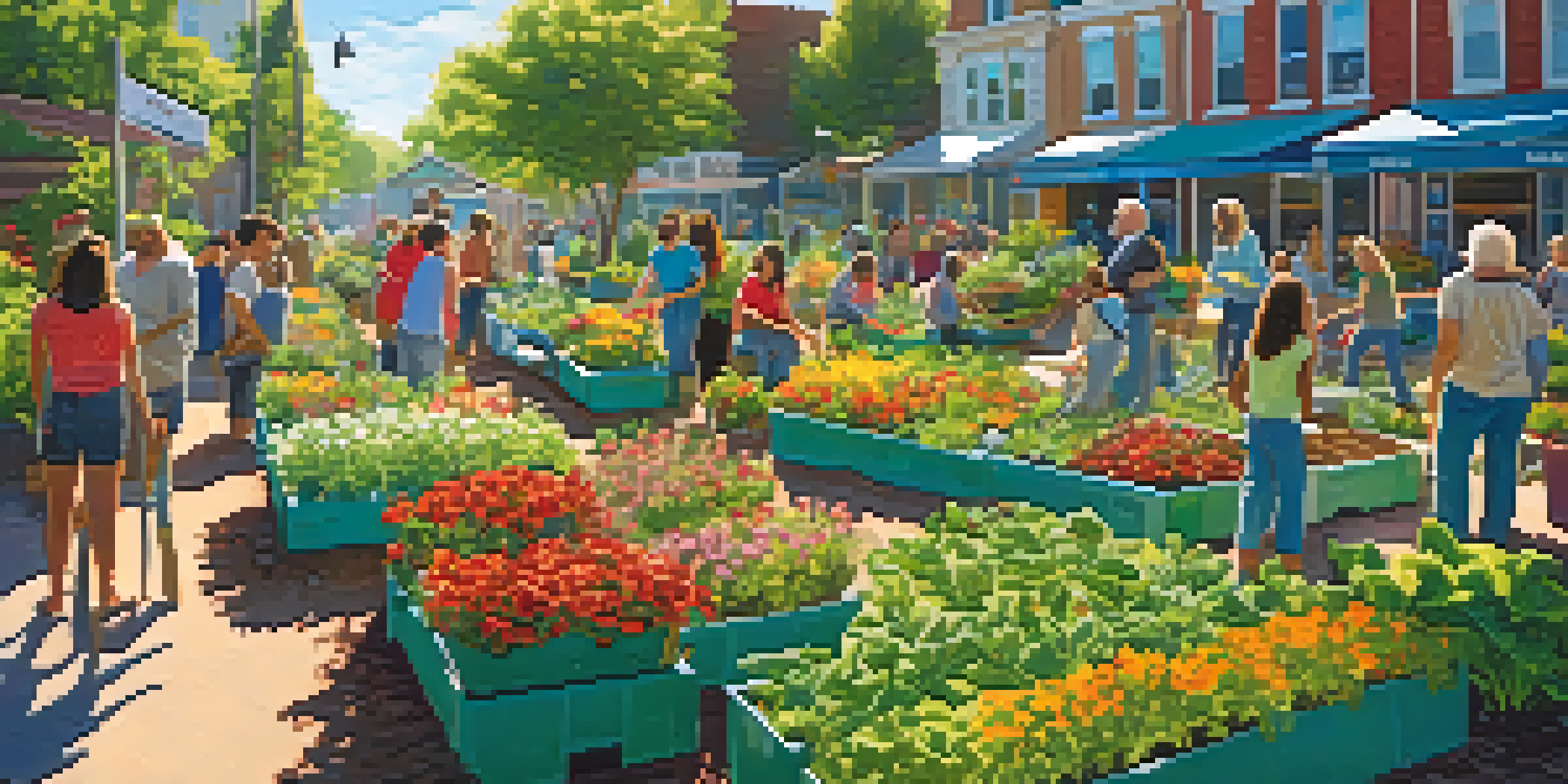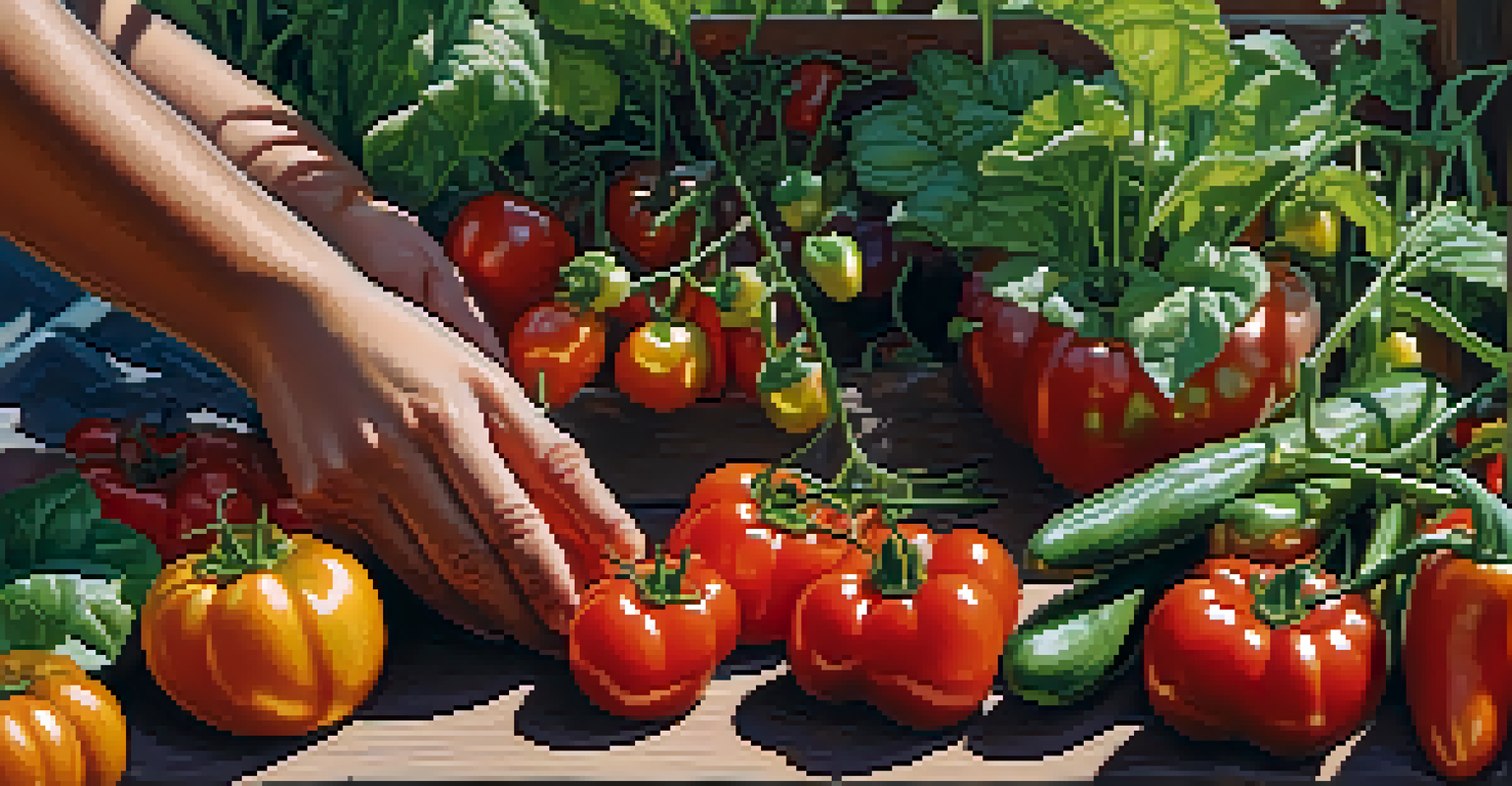The Role of Community Gardens in Austin's Food System

Understanding Community Gardens and Their Importance
Community gardens are shared spaces where individuals come together to grow fruits, vegetables, and herbs. These gardens not only provide fresh produce but also foster a sense of community and cooperation among residents. In Austin, such gardens have become vital in addressing food insecurity and promoting sustainable practices within the urban landscape.
Community gardens are a way for people to connect with their food, their community, and each other.
In essence, community gardens serve as a bridge between people and their food sources, allowing them to connect with nature and understand the journey of food from seed to table. Through these initiatives, gardeners learn valuable skills, from planting to harvesting, which can empower them to make healthier choices. Moreover, the collective effort cultivates friendships and community bonds that might not form otherwise.
With the rise of urbanization, spaces for growing food have diminished. Community gardens in Austin not only reclaim these spaces but also reinvigorate local ecosystems and contribute to biodiversity. They remind us that food can be both a personal and communal experience, celebrating the diverse culinary heritage of the city.
The Role of Community Gardens in Food Security
Food security means having reliable access to a sufficient quantity of affordable, nutritious food. In a city like Austin, where disparities in access exist, community gardens play a crucial role in bridging the gap. By providing fresh produce at little to no cost, these gardens help lower-income families access healthier food options.

Additionally, community gardens often implement programs aimed at educating residents about nutrition and cooking. This knowledge empowers individuals to make healthier choices and utilize the produce they grow effectively. When people learn to prepare meals with fresh ingredients, it not only enhances their diet but also encourages a sense of pride in their cooking.
Community Gardens Boost Food Security
These gardens provide fresh produce at little to no cost, helping lower-income families access healthier food options.
The impact of community gardens extends beyond individual households. As more families gain access to nutritious food, communities become healthier overall. This collective improvement can lead to reduced healthcare costs and increased productivity, showcasing how community gardens genuinely contribute to a more sustainable food system in Austin.
Fostering Community Bonds Through Gardening
Gardening can be a solitary activity, but community gardens transform this experience into a collaborative effort. Individuals from different backgrounds come together to cultivate shared spaces, creating not just food but friendships and connections. These interactions often lead to a greater sense of belonging, as community members work towards common goals.
The best part about community gardens is not just the food, but the lasting friendships that grow from the shared experience.
Events held at community gardens, such as potlucks, workshops, and volunteer days, provide opportunities for socialization and skill-sharing. These gatherings allow residents to bond over their successes and challenges in gardening, fostering a supportive environment. As people share their experiences, they also learn from one another, creating a rich tapestry of knowledge and culture.
Moreover, these gardens often become a hub for local events, further integrating them into the fabric of the community. By participating in communal activities, residents develop a deeper connection to their neighborhood, making them more likely to engage in other community initiatives. This sense of unity is essential for building resilience in the face of challenges.
Promoting Environmental Sustainability
Community gardens are not just about food; they also play a significant role in promoting environmental sustainability. By converting vacant lots into green spaces, these gardens help mitigate urban heat and improve air quality. Plants absorb carbon dioxide and release oxygen, contributing to a healthier urban environment.
Additionally, many community gardens practice organic gardening techniques, which minimize the use of harmful pesticides and fertilizers. This organic approach helps preserve soil health and protect local wildlife, promoting biodiversity within urban settings. By nurturing the environment, community gardens create a more sustainable food system for future generations.
Fostering Community Connections
Community gardens bring together residents from diverse backgrounds, creating friendships and a sense of belonging through shared gardening efforts.
Furthermore, these gardens encourage composting, which reduces waste and enriches the soil. Residents learn the importance of recycling organic waste, turning kitchen scraps into valuable resources for their gardens. This cycle of sustainability reinforces the connection between people and the planet, highlighting how community gardens can serve as a model for responsible living.
Encouraging Local Food Production
Community gardens empower individuals to grow their own food, which is a crucial aspect of local food systems. By cultivating their own produce, residents decrease their reliance on grocery stores and industrial agriculture. This shift not only supports personal health but also strengthens the local economy by keeping food production within the community.
As people grow food in their gardens, they often begin to share excess produce with neighbors, creating a culture of sharing and generosity. This practice not only reduces food waste but also enhances food diversity, allowing residents to enjoy a wider range of flavors and nutritional benefits. It’s a win-win scenario that fosters relationships while nourishing the community.
Moreover, community gardens can inspire local markets and restaurants to prioritize sourcing from local growers. When there’s an abundance of fresh produce available, it encourages chefs and business owners to incorporate these ingredients into their menus. This trend not only supports local economies but also promotes a farm-to-table philosophy that celebrates Austin's culinary scene.
Educational Opportunities Offered by Community Gardens
Beyond providing food, community gardens serve as excellent educational platforms. They offer workshops and hands-on training for individuals of all ages, focusing on gardening techniques, sustainable practices, and nutrition. These educational initiatives empower participants to take charge of their food choices, fostering a culture of learning and growth.
Children, in particular, benefit from these programs as they learn vital lessons about nature and responsibility. Working in the garden teaches them where food comes from and the importance of caring for the environment. These experiences can ignite a lifelong passion for gardening and healthy eating, influencing their choices as they grow.
Promoting Environmental Sustainability
By converting vacant lots into green spaces, community gardens improve urban ecosystems and encourage sustainable practices.
Additionally, community gardens often collaborate with local schools to integrate gardening into the curriculum. By providing students with practical experiences, they bridge the gap between theoretical knowledge and real-world applications. This hands-on approach not only enhances learning but also instills a sense of stewardship for the earth and its resources.
Challenges Facing Community Gardens in Austin
While community gardens offer numerous benefits, they also face several challenges in Austin. One significant hurdle is securing land, as urban development often encroaches on these green spaces. Rising property values can lead to the displacement of existing gardens, making it crucial for communities to advocate for the preservation of these vital resources.
Another challenge is maintaining community engagement over time. As people move in and out of neighborhoods, sustaining interest and involvement in gardening can be difficult. Community leaders often need to continuously promote the benefits of participating in gardening to keep the momentum going and ensure that the gardens remain vibrant and productive.

Moreover, funding can be a barrier for many community gardens, as they rely on donations and grants to support their initiatives. Establishing sustainable funding sources is essential for the longevity of these gardens. By fostering partnerships with local organizations and businesses, community gardens can secure the resources they need to thrive and continue contributing to Austin's food system.